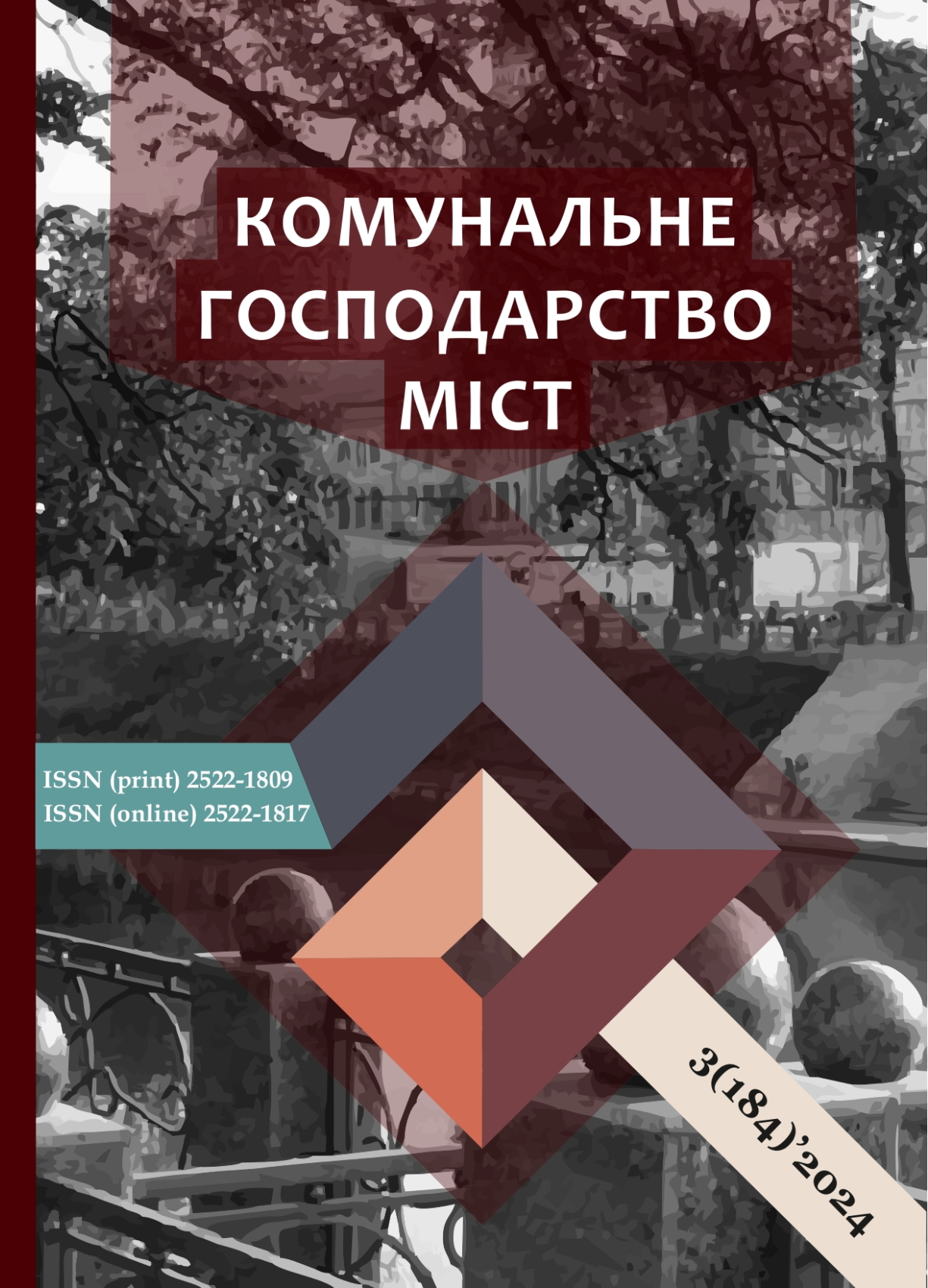CURRENT STATE AND DEVELOPMENT PROSPECTS FOR THE RENEWAL OF SEWERAGE NETWORKS IN KHARKIV CITY
DOI:
https://doi.org/10.33042/2522-1809-2024-3-184-118-123Keywords:
underground construction, sewerage, renewal, repair, reconstruction, bearing capacity, wear, corrosionAbstract
Ensuring the reliable operation of sewerage systems is one of the essential tasks of municipal services in Ukrainian cities. As the research shows, in most cases, their construction involved concrete and reinforced concrete, which are prone to destruction under the influence of many factors, particularly microbiological corrosion. The destruction of sewage collectors is often the reason for wastewater leaking into groundwater and soil, resulting in pollution. The article provides statistical data on the ‘Kharkivvodovidvedennia’ Complex of the ME ‘Kharkivvodokanal’ as of 01.01.2024, which operates the city’s external water drainage networks. The article outlines the most common factors that lead to emergencies in sewage networks, such as aging and wear of infrastructure, insufficient maintenance and repair, mechanical damage, pollution and clogging, increased volume of wastewater, planning problems, chemical reactions, biological corrosion, and connection defects. The relationship between these causes may be that corrosion can weaken pipeline materials, making them more vulnerable to mechanical damage and leakage. According to preliminary calculations, it is necessary to relay or rehabilitate (trenchless pipeline laying) at least 22–25 km of city networks annually to ensure the reliability of sewage networks. The article analyses the work cycles performed on the tunnel collectors’ objects and large-diameter collectors over five years. Major repair and reconstruction work that deserves attention includes work on the repair of mine No. 12 of the tunnel collector of the 761 micro-district (mine depth H = 6.75 m, diameter – 5 m); restoration work of the Oleksiivskyi collector Ø 2000 mm near the viewing chamber No. 33 on the street Lopanska; restoration of the collector of the Northern group of factories Ø 900 mm at Danylivskyi Uzviz. As a result, we carried out an analysis of the current state of the sewage network of the city of Kharkiv. The main factor in the wear and tear of sewerage networks is corrosion, which, in turn, can weaken pipeline materials, making them more vulnerable to mechanical damage and leaks. Despite the difficult economic conditions, work on the repair and operation of networks is carried out. Also worthy of special attention for future research is the survey of mines where restoration work took place over the past ten years using modern methods.
References
Gudilin R. I. (2021) Development of structural and techno-logical solutions for the repair and restoration of sewer collectors using clinker bricks: diss. Doctor of Philosophy: 192 – Construction and Civil Engineering. Kharkiv, KHNUBA, 137.
Aleynikova A., Hulevskyi P., Voronenko V. (2023) Organizational and technological solutions for the repair and restoration of sewer tunnels in the bordering areas with inspection shafts. Municipal Economy of Cities, 178 (4), 118-124. https://doi.org/10.1063/5.0143912
Anishchenko A., Aleinikova A., Kovalenko A., Nesterenko M., Nesterenko T. (2023) Technological package of the small-sized equipment for preparation of products from polystyrene-concrete mixture. AIP Conf. Proc., 2490 (1), 050027.
Hulevskyi P. (2020) Study of factors affecting the reliability of operation of sewage tunnels at the points of connection to inspection mines. Scientific Bulletin of Construction, 3, 94-98.
Goncharenko D., Karev A., Danchenko Yu., Degtyar E. (2021) Restoration of sewage collectors using anchor polyethylene sheets. Ukrainian Journal of Civil Engineering and Architecture, 5, 34-40.
Goncharenko D., Starkova O., Karahiaur A., Degtyar Y., Voskobiinyk O. (2023) Search for rational solutions for the repair and rehabilitation of shallow sewers. AIP Conference Proceedings, 2684, 030012. https://doi.org/10.1063/5.0120074
Iurchenko V., Melnikova O., Levashova Y., Kosenko N. (2023) Corrosion of Concrete in a Water Management Structure in Conditions of Biogenic Sulfuric Acid Aggression. Key Engineering Materials, 953. 55–62. https://doi.org/10.4028/p-0gbxtm
Kabus O., Lykhohrai V. (2023) Creation of combined polymer concrete surface layer to increase the efficiency of polymer coatings in sulfuric acid environment. AIP Conf. Proc., 2684 (1), 040008. https://doi.org/10.1063/5.0120064
Kostyuk T., Plugin A., Starkova O., Bondarenko D. (2021) Software tools for development of a methodology for selecting construction materials according to their performance characteristics. Reliability and durability of railway transport engineering structure and buildings, 2684 (1), 010001. https://pubs.aip.org/aip/acp/article/2684/1/040010/2893637.
Lyakhov I., Shumakov I., Ubyivovk A., Kupreichyk A. (2023) Experimental laboratory tests of piles with a polymer casing under the action of additional loading friction forces from soil subsidence. AIP Conf. Proc., 2490 (1), 040005. https://doi.org/10.1063/5.0124577
Molodid O., Plokhuta R., Musiiaka I., Reznichenko I. (2023) Sealing joints between concrete elements with polyurethane material. AIP Conf. Proc., 2684 (1), 040017. https://doi.org/10.1063/5.0120368
Plugin A., Donets O., Trykoz L., Pluhin O. (2023) Electromechanical control method of rheological and technological characteristics of building mixtures. Results in Engineering, 20, 101419. https://doi.org/10.1016/j.rineng.2023.101419
Downloads
Published
How to Cite
Issue
Section
License
The authors who publish in this collection agree with the following terms:
• The authors reserve the right to authorship of their work and give the magazine the right to first publish this work under the terms of license CC BY-NC-ND 4.0 (with the Designation of Authorship - Non-Commercial - Without Derivatives 4.0 International), which allows others to freely distribute the published work with a mandatory reference to the authors of the original work and the first publication of the work in this magazine.
• Authors have the right to make independent extra-exclusive work agreements in the form in which they were published by this magazine (for example, posting work in an electronic repository of an institution or publishing as part of a monograph), provided that the link to the first publication of the work in this journal is maintained. .
• Journal policy allows and encourages the publication of manuscripts on the Internet (for example, in institutions' repositories or on personal websites), both before the publication of this manuscript and during its editorial work, as it contributes to the emergence of productive scientific discussion and positively affects the efficiency and dynamics of the citation of the published work (see The Effect of Open Access).

